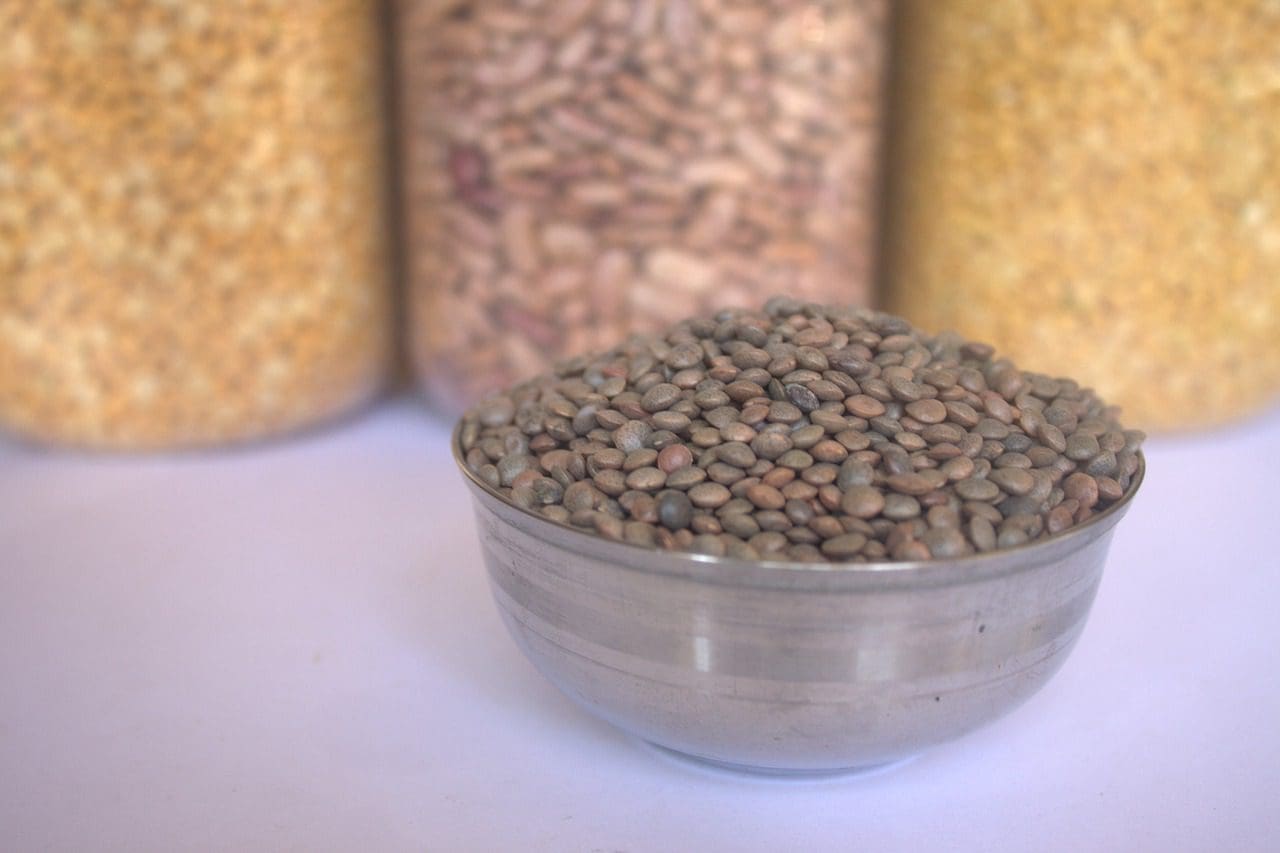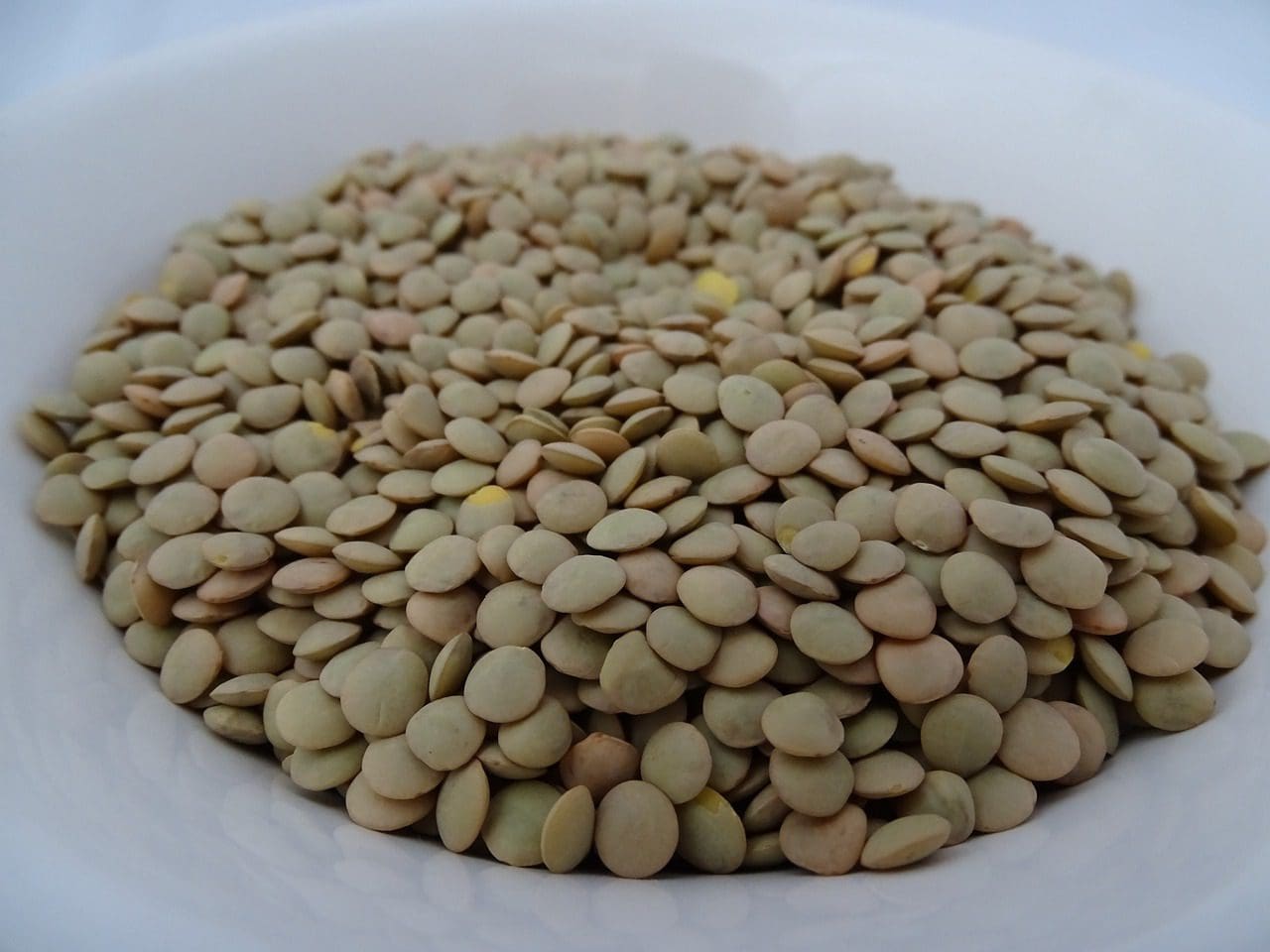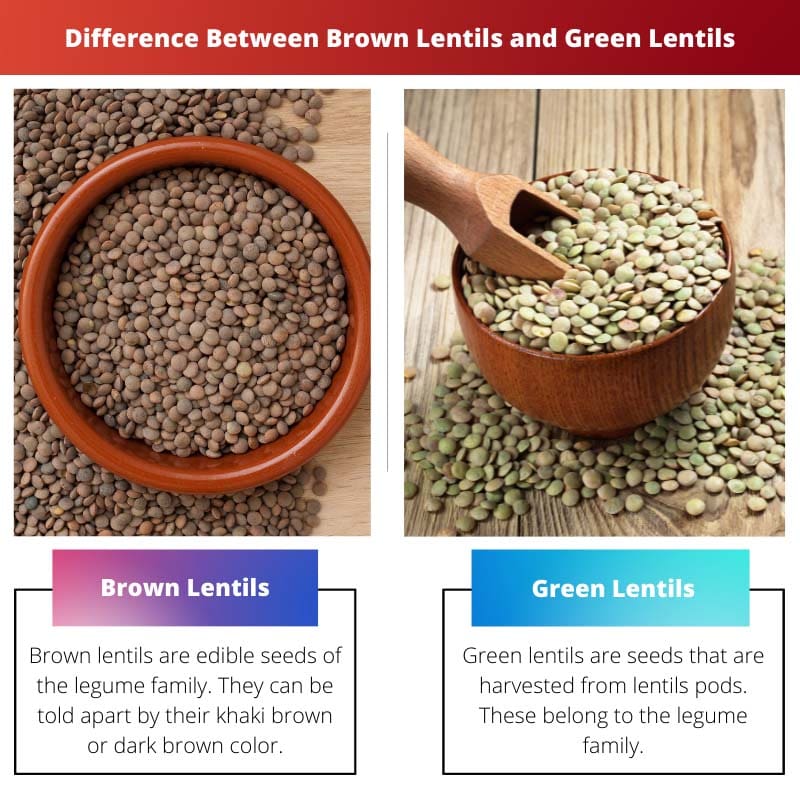Lentils are legumes that belong to the pea family. They are one of the most versatile and nutritious plant-based proteins available today.
These are small lens-shaped seeds that are harvested annually from lentil pods. Brown and green lentils are two varieties of this wholesome and affordable superfood.
Key Takeaways
- Brown lentils have a mild, earthy flavor, cook relatively quickly, and tend to become soft when cooked, making them suitable for soups and stews.
- Green lentils have a slightly peppery taste, require a longer cooking time, and maintain their shape better after cooking, making them ideal for salads and side dishes.
- The main differences between brown and green lentils are their taste, texture, and cooking characteristics, with brown lentils being softer and milder. In contrast, green lentils have a firmer texture and more distinct flavor.
Brown Lentils vs. Green Lentils
Small legumes with bawdy and mild flavor, used in soups, salads, stews being a rich source of fiber and proteins. Green lentils with small firm shapes rich with proteins and nutrients are used in soups and strews and side dishes.

The two lentils also have different cooking times. Green lentils take longer to cook than brown ones because of their harder outer layer. This hard skin also contributes to keeping the structure of green lentils intact despite the long cooking time.
Brown and green lentils can be added to soups, salads, veggie burgers, and much more. They can even be added to meals as a substitute for meat-based protein.
Comparison Table/h2>
| Parameters of Comparison | Brown Lentils | Green Lentils |
|---|---|---|
| Colour | Ranges from khaki brown to dark brown | Varies between pale greenish-brown and green-slate color with black and blue spots and a glossy surface |
| Taste | A mild and earthy flavor | Robust and peppery |
| Nutrition | Higher fiber content (half cup contains 26g fiber, 24g protein) | Low fiber content (half cup contains 10g fiber, 24g protein) |
| Size | All the seeds have a uniform size | Comes in a variety of sizes |
| Cooking Time | Shorter cooking time than green lentils | Longer cooking time than brown lentils |
What are Brown Lentils?
Brown lentils are edible seeds of the legume family. They can be told apart by their khaki brown or dark brown color. These seeds have a mild, earthy taste and work particularly well with salads and soups.
They can even be mashed into veggie burgers for a more savory flavor.
Brown lentils have a uniform size that is comparatively smaller than green lentils. This is one reason why it takes less time to cook them. Brown lentils are also known to hold their shape well after being cooked.
Brown lentils are available in varieties such as Spanish brown, Indian brown, German brown, or Bulga lentil. Bulga lentils are a variety that looks almost black. On being cooked, it looks like Bulga caviar (which is what the name is derived from).
Brown lentils are the most readily available lentils out of all. These can be found in almost every grocery store. The nutritional value makes this food appealing to consumers.
Brown lentils are a great source of fiber and protein. They are also rich in calcium, iron, phosphorus, and vitamin B sources.
Brown lentils are low in fat and sodium content. This makes them the perfect food for health enthusiasts. In today’s time, these lentils are also used as substitutes for meat-based protein sources in meals.

What are Green Lentils?
Green lentils are seeds that are harvested from lentil pods. These belong to the legume family. Their color ranges from pale green to green slate with blue and black spots. The seeds have a hard outer layer and a glossy exterior.
Green lentils have a robust and peppery taste. It takes longer to cook these seeds because of the hard outer covering. Due to this, these are perfect for stews and curries with long cooking times.
Green lentils can even be an inexpensive alternative for lentils du Puy (French green lentils).
Green lentils have a comparatively low fiber content than brown lentils. But these seeds are a rich source of protein, vitamins, and minerals. Interestingly, 26% of the calories in green lentils are counted as proteins.
These lentils, if dried, have a shelf life of up to one year. After cooking, they can be stored for three months if frozen and for up to one week if refrigerated.

Main Differences Between Brown Lentils and Green Lentils
- The color of brown lentils ranges from khaki brown to dark brown, while the color of green lentils ranges from pale greenish-brown to green-stale, with blue and black spots.
- Brown lentils taste mild and earthy, while green lentils have a robust and peppery flavor.
- Brown lentils have a higher fiber content than green lentils.
- Brown lentils are uniform, while green lentils have different sizes depending upon the variety of the seed.
- Green lentils have a harder outer covering than brown lentils.
- Brown lentils take 20-30 minutes to cook in a pressure cooker. On the other hand, green lentils take 30-40 minutes to cook in a pressure cooker because of their hard outer layer.

These lentils are an amazing source of plant-based protein and a great substitute for meat. I use them all the time in my cooking!
I couldn’t agree more! They’re nutritious, versatile, and delicious. They’re a staple in my diet.
The comparison table is really helpful for understanding the differences between brown and green lentils. It’s detailed and informative.
Agreed! It’s a great summary of the key points to consider when choosing which type of lentil to use in a recipe.
I never knew that green lentils had such a long shelf life after being dried. That’s a useful piece of information!
Absolutely! It’s good to know that green lentils can be stored for an extended period, especially if you cook in bulk.
Both brown and green lentils have their own place in various dishes. It’s fascinating to see how their taste, texture, and cooking times differ.
Absolutely! It’s essential to consider these differences when incorporating lentils into different recipes.
I never realized that green lentils contain such a high percentage of calories from protein. They’re an excellent source of plant-based protein!
Absolutely! Green lentils are a fantastic addition to a vegetarian or vegan diet because of their protein content.
Brown lentils are my go-to choice because of their mild flavor. They’re so versatile and can be used in many different dishes.
I’m the same way! Brown lentils are a staple in my kitchen, and I love experimenting with new recipes.
I had no idea there were so many varieties of brown lentils! I always assumed they were all the same. The nutritional value is impressive too.
The variety and nutritional content of brown lentils make them an essential part of a healthy diet.
I find the difference between brown and green lentils really interesting. The longer cooking time for green lentils is a key point to consider when choosing between the two.
Definitely! Green lentils can hold their shape better after cooking, which makes them ideal for certain dishes.
Informative article! It’s great to learn more about the different types and uses of lentils.
The comparison of brown and green lentils makes it clear that each type has its own unique characteristics. It’s helpful to understand the differences when cooking with them.
Definitely! Knowing the distinctions between brown and green lentils can influence how you use them in recipes.